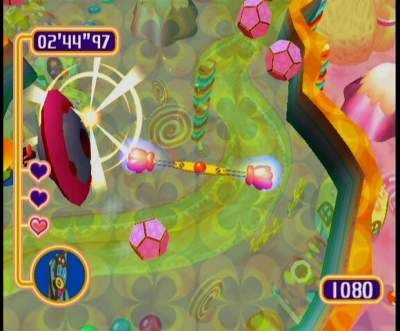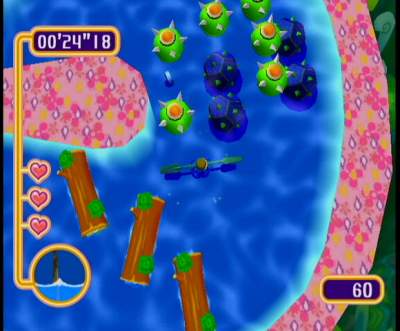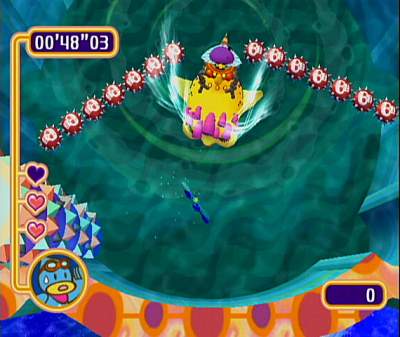Kururin Squash
To call upon a Louis Theroux-inspired in-joke-of-the-week: "No challenge."
Shop for games now with Simply Games.
Ah, this takes us back. School fetes, manoeuvring rings around twisty wire mazes without sounding a buzzer, perspiration accumulating in the furrows of our infant brow as we overcome the trickiest sections, and the eventual consolation of an "Aw, so close!" when our trademark steadiness eventually fails us and the buzzer cruelly sounds. We'd swear blind they magnetised bits of the wire to save on the lollypop prize budget. But we still wanted another go.
Kururin, in its various forms, is not much more than an update of that buzz bar idea. The goal is to direct a perpetually spinning stick around mazes using the analogue control without touching the sides or any of the course obstacles more than twice. With only a few health-replenishing spinny flower icons dotted throughout each level, and only the option to vary the speed of the stick-spin using the right shoulder button, any gamer can easily imagine how it challenges and how it locks you in with its charming simplicity.
Sticky situations

As it's grown from this simple template across three instalments (the first of which, Kuru Kuru Kururin, was among the first wave of Western GBA titles), Kururin has introduced other goals and quirks to the reaction-driven template. You also have to think about collecting 100 per cent of any given level's coins, spread around the play area and sometimes off the beaten track in side areas that involve risk as well as reward, and as we arrive at this Cube instalment, we discover that Nintendo's chosen developer Eighting has managed to expand the idea without separating it entirely from its charm, introducing variations like submersible craft, guns, boxing gloves, on-rails flamethrowing and even whirlwind-chucking and boss battles.
Playing it on anything larger than a 14" television is glorious overkill. The inescapable truth is that it would work just as well played on a Casio watch screen as long as the stick and the walls were distinct; the 3D backgrounds and bizarre, typically Japanese story sequences featuring our ducky hero and his hazard-prone adversaries are charming but totally unnecessary. And that's just as well, because sadly these new levels aren't as pure and addictive as straightforward Kururin puzzling, and as a result we'd recommend the series' previous offerings over this one, even if it were not because of Eighting's attempts to grow the formula.
But that's not to say that Kururin Squash is a bad example of a Kururin game by any stretch. The main puzzle mode, which features some 40 or so levels, never asks you to do more than get to the end without hitting the sides too much, even if it varies the manner in which you achieve this and likes to tease you with tricky-to-obtain loot whose precarious positioning threatens to undo the last few minutes worth of effort, and overall we had no qualms about sitting in front of this for several hours non-stop, just as we did with previous Kururin.
Duck and cover

Another option is a sort of 'race' mode where the challenge is not to collect loot and hitting the barriers is not such a worry, but instead the goal is to navigate similar but distinctly simpler Kururin mazes and hit the goal within the target time. To make things a bit less frustrating, these levels are also split up by regular checkpoints, to which you'll return if you take just two hits in any given section.
There's also a multiplayer mode that supports this manner of racing for up to four players in split-screen, which can be manic when your sticks are clanging together, and finally there's a deathmatch-ish mode, which treats the game's new abilities like the flamethrower and boxing gloves as short-burst power-ups in a competitive mode reminiscent of Super Monkey Ball's Monkey Target, where the goal is to finish up with the most coins by grabbing any that are strewn about and mashing your friends to mug them of their accumulated wealth.
Returning though to the leading light of the piece, the puzzle mode, it's pleasing to note that the level design can be as inventive as ever. Basic puzzle levels, featuring nothing more than a rotating stick, are definitely the most satisfying, as you strain to manoeuvre the spinning stick around tightly constructed mazes without incurring damage, using bounce pads to change the spin direction and avoid touching the sides, and dodging block-crushers and other moving obstacles at the same time. At its absolute best you'll be changing spin direction fluidly as you navigate tight, impossibly twisty pathways, and you'll emerge with a huge grin on your face. But, to be fair, the variations have their moments too. The submarine in particular, which brings with it the ability to dive underwater for a spell (the "water meter" in this case being the sight of the little ducky's icon in the bottom left gradually filling up with water as he pants and cries out) adds obvious depth, exploited by Eighting with mines and coins on the surface as well as underwater, various other surface obstacles like logs and a mixture of rapids and whirlpools to propel them - and you - around in a manner that demands more of your eager thumbs than regular levels.
Billed prominently

Boxing gloves, meanwhile, allow you to smash up enemies (the more challenging of which herald some coinage and do not respawn), while the projectile-firing effort has you doing similar but with steadier streams of enemies to dodge (including ChuChu Rocket-style trains of what we think are mice, and, at its best, huge caterpillars barrelling after you like that rock in Raiders of the Lost Ark), and introduces mazes of green red blocks that bar the way and have to be excised by hunting down the destructible green blob which then blows the rest up along with any circling enemies in a flashy chain reaction. Hitting things with your projectiles is all the more difficult when you can't stop spinning, of course.
Then there are the whirlwind levels, which are some of the most traditionally puzzle-like, allowing you to charge up twisters by holding A and then unleash them in a chosen direction to strike at enemies, block off streams of fire, blow cloud cover out of the way, and spin large propellers that bar your progress; doing so also involves judging whether or not the movement of the blades will uncork flamethrowers that you can't dodge, and planning against such an eventuality.
Apart from one final spinny alternative, flamethrowing's the only other thing - and interestingly it's on rails, the idea being to spit flame (a beautiful effect, incidentally) by holding A and using the analogue stick to twist your chopper blade as you see fit to dodge track-side obstacles and enemies. You can speed up movement by holding B, which also extends reach of the fire, and Eighting often keeps you moving faster than you can really cope or pursues you with big enemies who take some whittling down before they die and will catch up unless you keep them at arm's length by using B to set a solid pace.
Boss design, finally, plays on each of these themes one by one. The first boss, for example, sits in the middle of the screen rotating his surroundings (including obstacles that you have to dodge), and you have to whack things with your boxing glove so they tumble into his command console and kill him off. In a sense, it's not just one good puzzle game idea, but a group of them built around a simple, almost faultlessly executed premise.
Increasingly fowl?

Or it would be, if it weren't for the fact that it isn't faultlessly executed at all. Heading into the main puzzle mode we easily steamrollered through much of the game in one evening, pausing to catch our breath and realising we were only a stone's throw from the final boss. The problems begin with the design of the levels. While they do challenge you from time to time, and gathering all the treasure will keep you busy, the vast majority yielded 100 per cent of their wares to us on the first go. Only a fraction of them needed us to run through them more than once or twice to obtain everything, and even the bosses rarely took more than a couple of tries. Even if your mileage does vary, surely it won't by the sort of margin required to stretch Kururin Squash out over more than a Sunday afternoon.
Ironically, as much as we owe this failing to lenient level design, superior controls are also to blame. The digital response of the GBA titles often made it harder, but the analogue control here is deadly smooth. The stick goes precisely where you want it to go and allows for much finer control through tricky situations, while the levels don't clamp down on you to compensate.
We also feel that it was slightly misguided to flesh it all out with the racing mode bit, even if it has worked before. It's more Time Trial in its approach than anything else, with levels unlocked more or less from the get-go, and arguably could have done with losing the checkpoints to up the ante and giving us multiple, staggered goal times to aspire to instead. We would have preferred twice as many regular puzzle levels to this against-the-clock stuff, really, and as a multiplayer mode it only works when all the players are at a similar skill level. Admittedly getting to a similar level isn't massively difficult, but how likely is it as a regular pick-up game with that in mind? And, while we're on the attack, we never did shake the feeling that, while attempts to break free of the central spinny evasion idea are admirable, they never really do as much for us as the pure alternative.
Finally the deathmatch mode. Initially we thought it was a bit unbalanced. It does, after all, combine a number of power-ups that were designed for the single-player game and then thrown together without warning. But in time it reveals itself to be a more Monkey Target-esque luck of the draw scenario, and with four players it can be manic. It's got a certain charm about it, that's for sure. But as for whether it's manic enough to displace the likes of Monkey Ball and Mario Kart in the grand scheme of Cube party pieces, we have our doubts. More likely it's half an hour's entertainment halfway through an evening in with your mates.
Contorted
The net result of which is that you'll have tremendous fun playing Kururin Squash while it lasts, but that for all its improvements and clever ideas it's let down by an unfortunate shortfall in the quantity and quality of its levels. It just doesn't push you hard enough or for long enough, and the extras (also including a throwaway downloadable GBA mini-game) don't add much. In the end it's not worth what it'll probably cost you to import (despite its budget price point in Japan, you're bound to encounter import mark-up), and while we'd dearly love to see things like this cross the void between Japan and the West, it's hard to recommend this one particularly. If you've not played Kururin before, you should, but unless you haven't got a Game Boy you should look for Kuru Kuru Kururin or the Japanese sequel Kururin Paradise on eBay instead.
That said, if you are a Kururin vet and happen to stumble across Squash for £16 while trawling importers on a darkening afternoon in Soho as we did, it's an evening of all the beautiful, quirkily executed ideas from which are modern story-driven third-person action-blockbuster wotsits were originally derived, calling for speedy reactions and a touch of lateral thinking, and you will have fun. Just not enough of it. In other words, it'll captivate you for as long as it lasts, but don't be surprised if it then spins off onto a shelf with only a duck in a helicopter's chance of ever returning to the fore.
Shop for games now with Simply Games.








